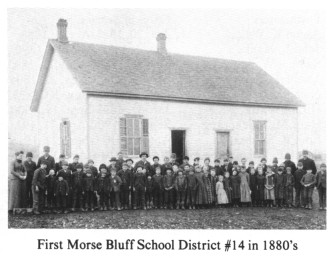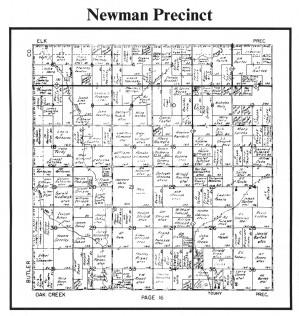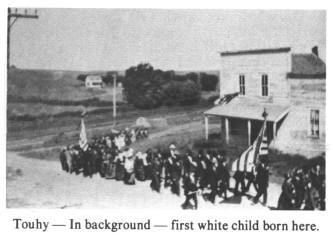 |
MORSE BLUFF PRECINCT |
owned shed off the school grounds. Students up to 21 years of age came just to learn to read and write. There were many more pupils from December to April after they helped complete harvest and before spring farm work began. A resident of Saunders County remembers an incident back in 1895 when the superintendent, who was known to take a few drinks, fell asleep at his desk shortly after school started. One of the bigger boys set the clock ahead to 11:30AM. The superintendent, upon awakening, saw it was time to dismiss for lunch. He went to an eatery, found no lunch prepared, got into an argument with the owner, and returned to school with a black eye. A second frame building was constructed just west of the present school in 1895. In 1900, the curriculum included classes for 9th and 10th grade students. Mary Vopalensky and Ray Killian were members of the first graduating class there in 1902. Walter Fleming, a present resident in the district, was the only member of the second graduating class in 1903, and his wife, the former Louise Seligmann, was the only member of the third graduating class of 1904. The present brick building was completed in September 1923. The 9th and 10th grades were discontinued after the 1951-52 school term. Some school districts adjoining Morse Bluff consolidated with it. They were as follows: District #15 in 1960, District #79 in 1963, and District #77, 78, and 86 in 1970. In 1968 an election was held to determine whether District #14 would join other districts in forming a new class six district in North Bend. This proposal was passed by all districts involved and North Bend Central Junior-Senior High School (District #95) became one of the first class six districts in the state. With the building of a new Junior-Senior High School in North Bend in 1969 further changes occurred. Since the 1968-69 school term, students in grades 7 and 8 receive Junior high education in North Bend. Many of these Junior High along with Senior High students are transported by bus. The school presently has 42 students in kindergarten thru the sixth grade with three full time and one part time teacher, an aide, and janitor. We are proud of our school and the pupils that have gone on to become leaders in their high school, college, and community. I'm sure many of you reading this now could tell stories comparable to the one that happened at this school way back in 1895. Hopefully, this story will remind former Morse Bluff students of fond school memories. Submitted by Deanna Wolf SCHOOL DISTRICT #54Early records show in 1872 the Director of District #54 was M.A. Malloy. Mary Fleming was the teacher with an enrollment of 36. She received a salary of $25. a month for a four month term. In 1873 the term was increased to five and a half months with a salary of $26. a month. In 1875 school was in session two terms of three months each. In 1876 Walter Fleming taught three months at $40. a month. Ellie Nicols taught three months at a salary of $25. a month. Maggie Krause taught in 1878. Mary Malloy taught the second three month term. There were 32 pupils enrolled with average attendance of twelve. Present day teacher is Donna Vacha of Cedar Bluffs with an enrollment of five pupils. They are Greg Hines, Billy Kavan, Bobby Kavan, Dwayne Kavan, and Timmie Kavan. The school joined other districts in the area in 1968 to form a Class VI District in North Bend so the grade level is Kingergarten to sixth. Present day school board members are Francis Zakovec, Debbie Kavan, and Larry Racek. SCHOOL DISTRICT #91The first record of District #91 is in 1878. The Director was Mr. E.D. Malloy, whose post office address was Sand Creek. There were seventeen pupils in attendance and the number of days taught were 120. The present brick building was constructed in 1938. The oldest living resident in the district in 1983 is Joe Sweet. The school has sometimes been referred to as the Hartford School since four generations of Hartfords have lived in and attended school in District #91. A tradition of the District through its entire history has been a Christmas program each year and a District patrons picnic at the close of the school year. At the present time, nine pupils are enrolled in the school, namely, Malinda Hartford, Crystal Johnson, Becky Vech, Missy Johnson, Brian Vech, Melissa Hartford, Robbie Kruger, Bobbie Hansen and Marsha Zakovec. The present members of the school board are Olga Virka, president, Eugene Hartford, secretary and Mary Johnson, treasurer. ARTIST PRESERVES WILDLIFE |
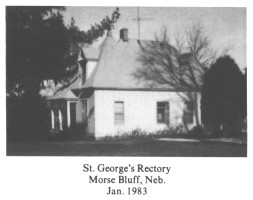 |
| St. George's Rectory Morse Bluff, Neb. Jan.1983 |
In the beginning of 1945 two prominent businessmen of Morse Bluff, Mr. Emil Wolf and Mr. Phillip Walla conferred with Rev. Bishop Louis B. Kucera. Mr. Wolf offered a garage dance hall, which he owned, free of charge, to be used as a temporary chapel. Mr. Walla promised a house, which he owned, to be used for the Pastor to live in when it became available. It was a small house with no modern conveniences. The Pastor received a small main altar for the Chapel from the Catholic Extension Society. The side altars and pews were given to him by neighboring parishes. The Rev. George J. Livanec said his first Mass in the St. George Chapel on July 1,1945.
In 1951, Father Livanec acquired a large comfortable home with enough adjoining ground where the new church was planned to be built. The property was sold by Wilma Kunkle to St. Georges Catholic Church. Lots 9,10,11,12,13, l4 and 15 in Block 8 for the sum of $6375.00.
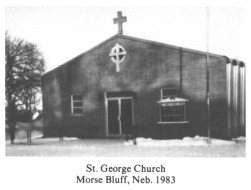 |
| St. George Church Morse Bluff, Neb. 1983 |
page 95
|
In October 1954, construction was started on the new church. The church was built of metal with a brick front. The building consists of the church 39 X 80 feet and a social hall 39 X 37 feet, at the cost of $24,000 and 4500 hours of donated labor. It was completed in 1955. The corner-stone was laid by the Dean Monsignor Matthew V. Nemec on September 25, 1955. That day the first Mass was offered in the new church. The St. Georges Church was dedicated on Wednesday, December 21, 1955. The Most Reverend Louis B. Kucera, Bishop of Lincoln, Nebraska officiated at the dedication and offered the Solemn Pontifical Mass. At that time the Sacred Heart Church of Cedar Hill again became a mission church to St. Georges Church of Morse Bluff, Nebraska. August 5, 1961, Rev. George J. Livanec passed away. Following his death Rev. John Kozlik of Cedar Bluffs, Nebraska offered Sunday masses until in October 1961. Rev. Henry Denis was appointed to serve the Morse Bluff and Cedar Hill Parishes. Rev. Henry Denis served from 1961 to 1974, Rev. Otto Ekhaml served from 1974 to 1978, Rev. Jerome Pokorny from 1978 to 1979, Rev. Jack Hebert from 1979 to 1982 and Rev. Meldon Wass is the present Pastor. by Albin L. Cihacek UNITED STATES POST OFFICESEstablished as Slavonia on Dec 12, 1872 Postmasters: Dates of Service Fredric F. Doubrva Dec.12, 1872-May 12, 1874 Bissel P. Rice May 13, 1874-Jan. 29, 1876 James H. Noteware Feb. 1, 1876-Sept. 17, 1877 Harriet S.C. Noteware Sept.18, 1877-Oct. 23, 1882 Rainsford Brownell Oct.24, 1882-Jan. 15, 1888 Rainsford C. Brownell Jan.16, 1888-Mar. 10, 1888 Benton, Saunders County Established on June 8, 1868 Discontinued on April 23, 1877 Morse Bluff, Saunders County Established on January 20,1888 |
| Back | Contents | Next |
The Saunders County NEGenWeb Project
